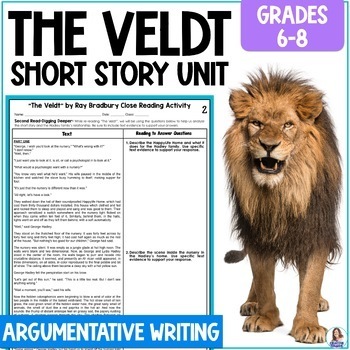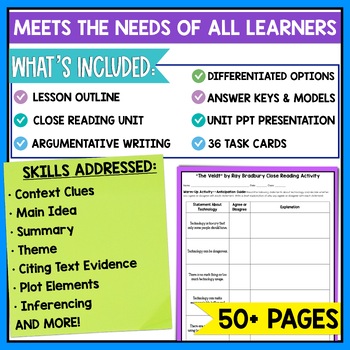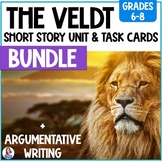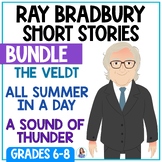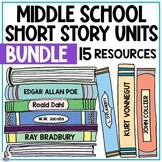The Veldt by Ray Bradbury - Short Story Unit - Argumentative Writing Task
- Zip
What educators are saying
Also included in
- Are you looking for a short story unit that will pique your students’ interest and encourage their curiosity? How about a short story set in a futuristic dystopian society where technology can replace even the most basic of human activities and has one of the most jaw-dropping endings in literature?Price $8.99Original Price $11.95Save $2.96
- The Ray Bradbury Short Story Bundle contains multiple short story units for "All Summer in a Day", "A Sound of Thunder", and "The Veldt": two close reading units that include differentiated materials, narrative writing task, and argumentative writing task as well as 36 creative and higher order thinPrice $21.99Original Price $33.46Save $11.47
- Are you looking for a variety of Middle School ELA resources for short stories that contain engaging, rigorous, and differentiated materials? The Middle School ELA Short Story Bundle contains 15 individual short story units and lessons from my store and any future short story resources will be addedPrice $62.99Original Price $91.62Save $28.63
Description
Are you looking for a short story unit that will pique your students’ interest and encourage their curiosity while reading "The Veldt" by Ray Bradbury? How about a dystopian short story set in a futuristic society where technology can replace even the most basic of human activities and has one of the most jaw-dropping endings in literature? Look no further than this “The Veldt” Short Story Unit that is is aligned to the Common Core State Standards for 6th, 7th, and 8th grade ELA . This two week long differentiated unit is full of high quality and critical thinking reading comprehension activities to accompany this timeless short story.
Students will LOVE that they are engaged in an ongoing discussion of technology and given the opportunity to voice their opinions on who it to blame for the tragic ending. Teachers will LOVE that this unit contains scaffolded and differentiated close reading activities that are designed to help students deeply analyze the characters and events in this short story as well as the big question of “Is too much technology a bad thing?”. This will help students not only tackle complex texts and skills, but also create a logical argumentative writing response that is based upon what they have learned from reading the short story. In addition, everything that teachers needs to implement this unit, from teacher models, teacher tips, and a detailed presentation, is included in this download.
✍ This resource covers the following Common Core Standards:
•RL.6-8.1
•RL.6-8.2
•RL.6-8.3
•RL.6-8.5
•W.6-8.1
•w.6-8.2
•W.6-8.4
•W.6-8.5
✅ Skills Focused On During Unit:
• Main Idea/Objective Summary
• Inferences
• Characterization
• Making Predictions
• Context Clues
• Story Elements
• Foreshadowing
• Theme
• Argumentative Writing
⭐⭐⭐ Grab the The Veldt Short Story Task Cards for CCSS-aligned questions and creative projects that students can create to show their new learning and understanding of the story!
► What's Included:
• “The Veldt” Anticipation and Reaction Guide: Students will read a series of statements about technology. They must decide if they agree or disagree with each statement. In addition, they will need to explain their reasons for agreeing or disagreeing with each statement. In the reaction guide, they will be required to use specific text evidence from the story to support why they agree or disagree with each statement.
• “The Veldt” Probable Passage: Students are given several words from the short story and must categorize them into one of five categories: Setting, Character, Conflict, Outcome, or Unknown Word. Once students have categorized their words, they will develop questions that they have based on the words or the story. The final step in this pre-reading activity requires students to use their categorization to create a prediction on what they think will happen in this short story.
• “The Veldt” Differentiated Vocabulary and Context Clues Activity: Students will use context clues to identify unfamiliar words from the short story. The activity uses the actual text from the story where the word is used. After students select the correct multiple choice answer, they are required to write a one sentence justification using text evidence.
• “The Veldt” Close Reading Activity:
• During this scaffolded close reading activity, students will first read the story to get the gist of what is happening and will use this information to write an objective summary of the short story.
• In the second read, students will dig deeper into the story using some guiding questions and will culminate with students explaining and analyzing the use of foreshadowing in the story. There are three options for the Second Read. A 2nd option that includes the use of Two Column Notes Organizer and chunked text has been included for struggling readers.
• Next, they will analyze the technology in the story and the impact that it has on the characters. This activity culminates with students creating an extended writing response where they use the information they have gathered to identify the theme of the short story and will have to use textual evidence to support their answer.
• “The Veldt” Assessment: This assessment contains six multiple choice questions that cover context clues, theme, story elements, and the role of tone/mood in the story. Students must write a one sentence justification to support their answer choice. In addition, there are two constructed response questions. This allows students the choice of which constructed response they want to answer.
• “The Veldt” Argumentative Writing Task: The Argumentative Writing Task contains everything needed for both teacher and students to complete this task. Students will write an argumentative response that includes a claim that is supported by clear reasons and strong textual evidence.
❯ Task #1-Pre-writing
❯ Task #2-Rough Draft
❯ Task #3-Self and Peer Assessment
❯ Task #4-Final Draft
❯ Argumentative Writing Reference Sheet
❯ “The Veldt” Argumentative Writing Task Rubric
• “The Veldt” Choice Board Activity (EARLY FINISHERS ACTIVITY): This activity can be used as an alternate assessment activity or as an early finisher for students who finish any part of this unit before other students. It includes four tasks for students and clear specific criteria for each task. In addition, teacher models for each task have been included to help students know what their work should look like to be high quality.
• Teacher Models and Answer Keys: Teacher models and answer keys have been provided.
• “The Veldt” Lesson Presentation: This presentation is designed to help guide both teacher and students through this week long unit. There are 23 blank/editable slides that you can us to customize the presentation to better suit the needs of your students/classroom.
• “The Veldt” Lesson Outline Notes: This lesson outline is a PDF version of the activities from this unit. It includes suggested modifications/explanations, teacher tips, and more to help guide teachers through setting up and effectively organizing this unit.
• Bonus Activity: This bonus activity centers around the Disney film Smart House. Students will view the film and answer questions on a viewing guide. Students will then compare and contrast the similar themes in “The Veldt” and “Smart House” to analyze how each film tackles the similar theme.
-------------------------------------------------------------------------------------------
What Other Teachers Are Saying About This Resource:
⭐⭐⭐⭐⭐: Joshua K. says, "Very thorough and complete. It is apparent that a lot of thought went into this product. I really like how the argumentative writing component is broken into steps and parts. It really helped my students write better argumentative papers."
⭐⭐⭐⭐⭐: Learn and Grow Dailey says, "We use this with our Advanced 6th grade class and sometimes our average/above average reading group. The activities are thought provoking and thorough, and we love that it allows for a range of abilities. Thanks for a great resource!"
⭐⭐⭐⭐⭐: Jennifer S. says, "Such a thorough, rigorous, and relevant product! You can't teach "The Veldt" without this one!"
---------------------------------------------------------------------------------------------
Please be sure to download the preview file to see exactly what you are getting when you purchase this product!
Created by Stephanie M. Icenogle, The Creative Classroom © 2016; updated © 2022
All rights reserved by author.
Permission to copy for single classroom use only.
Electronic distribution limited to single classroom use only.

